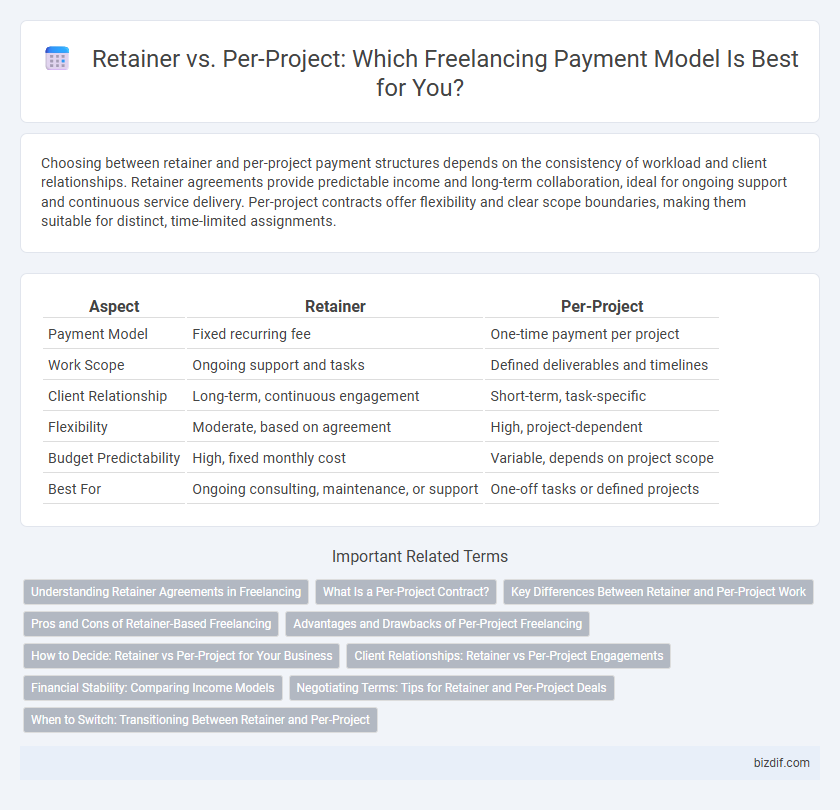Choosing between retainer and per-project payment structures depends on the consistency of workload and client relationships. Retainer agreements provide predictable income and long-term collaboration, ideal for ongoing support and continuous service delivery. Per-project contracts offer flexibility and clear scope boundaries, making them suitable for distinct, time-limited assignments.
Table of Comparison
| Aspect | Retainer | Per-Project |
|---|---|---|
| Payment Model | Fixed recurring fee | One-time payment per project |
| Work Scope | Ongoing support and tasks | Defined deliverables and timelines |
| Client Relationship | Long-term, continuous engagement | Short-term, task-specific |
| Flexibility | Moderate, based on agreement | High, project-dependent |
| Budget Predictability | High, fixed monthly cost | Variable, depends on project scope |
| Best For | Ongoing consulting, maintenance, or support | One-off tasks or defined projects |
Understanding Retainer Agreements in Freelancing
Retainer agreements in freelancing provide clients with guaranteed access to a freelancer's services over a specified period, often resulting in steady income and stronger professional relationships. These agreements typically outline the scope, availability, and payment terms, ensuring clarity and commitment from both parties. Compared to per-project contracts, retainers offer predictability and long-term collaboration, making them ideal for ongoing or evolving client needs.
What Is a Per-Project Contract?
A per-project contract in freelancing defines a specific scope of work with a clear start and end date, where payment is made upon completion of agreed deliverables. This model provides clients with flexibility and cost control by assigning fixed fees per project, often detailed in a written agreement outlining milestones and deadlines. Freelancers benefit from clear expectations and the ability to negotiate terms based on the complexity and duration of each unique task.
Key Differences Between Retainer and Per-Project Work
Retainer work involves a consistent monthly fee for ongoing services, ensuring priority access and stability, while per-project work requires payment upon project completion without guaranteed workload continuity. Retainers typically foster long-term client relationships and steady cash flow, whereas per-project engagements offer flexibility and varied income opportunities. Understanding these differences helps freelancers choose between predictable earnings with retainers and the adaptability of project-based work.
Pros and Cons of Retainer-Based Freelancing
Retainer-based freelancing offers consistent income stability and stronger client relationships through long-term commitments, but it may limit flexibility and require ongoing availability that can reduce time for other projects. Clients benefit from prioritized service and faster turnaround times, while freelancers face the risk of workload imbalance if the retainer terms are not clearly defined. This model suits freelancers seeking predictable cash flow but demands effective communication and clear contract scope to avoid scope creep and burnout.
Advantages and Drawbacks of Per-Project Freelancing
Per-project freelancing offers clear scope and budget, allowing clients to define specific deliverables and timelines, which minimizes ambiguity and aids in precise cost estimation. This model provides freelancers with flexibility to manage multiple projects simultaneously but can lead to inconsistent income and the potential for scope creep if project boundaries are not well-defined. While it supports targeted expertise and project-based payments, the lack of ongoing client relationship may limit long-term collaboration opportunities compared to retainer agreements.
How to Decide: Retainer vs Per-Project for Your Business
Choosing between retainer and per-project pricing depends on your business goals and cash flow stability. Retainers provide predictable monthly income and foster long-term client relationships, ideal for ongoing work and consistent support. Per-project pricing suits businesses with fluctuating workloads and a focus on clearly defined, one-time deliverables.
Client Relationships: Retainer vs Per-Project Engagements
Retainer agreements foster long-term client relationships by providing consistent support and prioritized access to services, ensuring ongoing collaboration and trust. Per-project engagements offer flexibility and clear deliverables but may limit opportunities for deep client understanding and continuous improvement. Choosing retainers enhances client retention and predictable income, while per-project models suit clients needing specific, short-term expertise.
Financial Stability: Comparing Income Models
Retainer agreements provide consistent monthly income, enhancing financial stability for freelancers by ensuring steady cash flow and predictable budgeting. Per-project payment models offer flexibility but may result in income fluctuations, making financial planning more challenging. Choosing a retainer model supports long-term financial security, while per-project work can maximize earnings during peak demand periods.
Negotiating Terms: Tips for Retainer and Per-Project Deals
Negotiating terms for retainer deals involves clearly defining the scope of work, payment schedule, and cancellation policies to ensure steady income and client commitment. For per-project agreements, specifying deliverables, deadlines, revision limits, and milestone payments protects both parties and facilitates transparent expectations. Detailed contracts and open communication are essential to tailor terms that reflect workload, budget constraints, and project complexity, optimizing freelancer-client relationships.
When to Switch: Transitioning Between Retainer and Per-Project
Freelancers should consider switching from per-project to retainer models when they have established consistent client demand and require stable monthly income for better cash flow management. Transitioning back to per-project work is ideal when project variety increases or client needs become sporadic, allowing greater flexibility and control over workload. Evaluating client relationships, payment reliability, and project complexity helps determine the optimal time to adjust between retainer and per-project engagements.
Retainer vs Per-project Infographic

 bizdif.com
bizdif.com